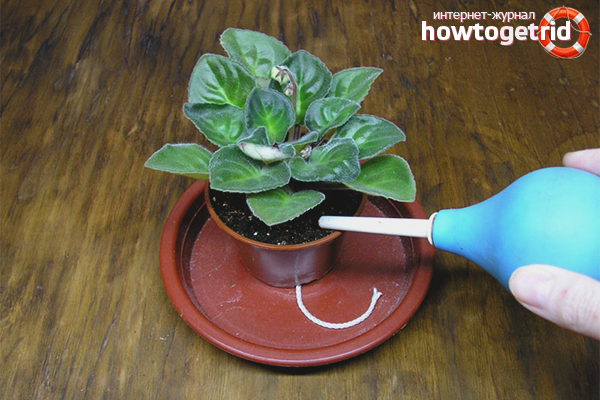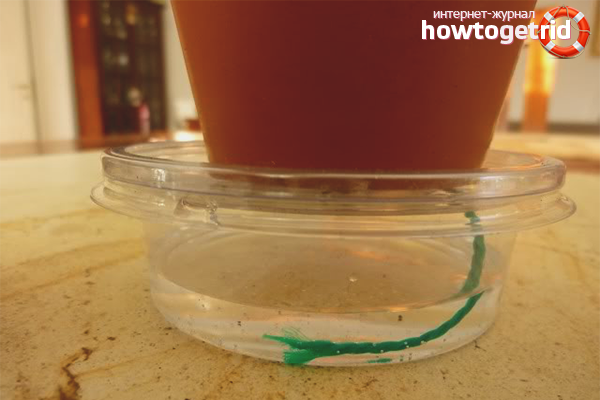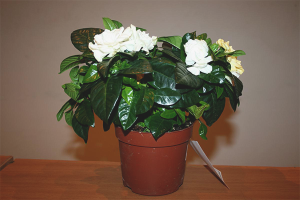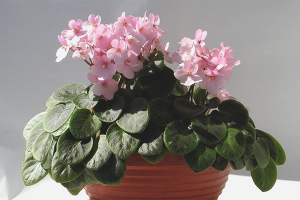The content of the article
Watering is an important component of the full-fledged agro-technology of violets. Moreover, it is correct. After all, these small plants can not be watered in the usual way. Almost what’s wrong - immediately illness, rot, whims, wilting.
Many pour water into the pan. But this method also has its own characteristics. How to water violets at home? Let's figure it out together.
Classic method
Top violets can be watered. But not from a watering can with a spray. Water should fall either almost under the root or along the very edge of the pot. A syringe, a large syringe without a needle, a watering can with a long narrow nose, are well suited for this method.
It is desirable that the water does not leak out, namely it is absorbed. Otherwise, the soil will be washed out. This can be achieved by resting the nose directly into the soil. So there will be no splashes that fall on the leaves and form spots.
The fluid is poured until it begins to protrude on the pallet. After the procedure, they wait another 10 minutes, then the excess is drained. If this is neglected, the roots will quickly cool down and begin to rot.
Immersion method
You can’t just pour water into the pan and wait for the violet to get drunk. Drainage will not allow the normal amount of fluid to rise up. We'll have to wait too long for the earthen lump to saturate well. During this time, the water will have time to cool. And violets do not like the cold.
The right thing to do is:
- Take a container whose diameter is slightly larger than the pot with violet.
- Put the pot itself in an empty bowl.
- Pour warm (+ 38-42 ° С) water into the tank, approximately at the level of one third of the pot.
- They are taken out when the topsoil darkens slightly.
- Pull out the pot with violet, put it on an inverted tray to drain excess water.
- As soon as the liquid ceases to drain, the flower is returned to its usual place.
With this method, water does not directly get on the violet itself. So the risk of disease or rotting is minimal.
Wick method
Used for a long time, known to many. It has some inconvenience. In the cool season, you need to carefully control the temperature of the water. But we know one secret that calmly fixes this problem. Why is not indicated in a single source - science does not know.
To equip the structure you will need:
- the violet itself in a pot
- low transparent container with a hole in the lid (4-5 cm high)
- wooden stick, knitting needle, long thin tweezers
- piece of twine or cotton cord (about 9-12 cm)
Procedure. In the drainage hole at the bottom of the pot with a wooden stick or needle (tweezers), you must carefully shove the cord or twine. Approximately 4 cm. Insert the second end of the rope into the hole on the lid of the prepared container. This must be done so that the bottom of the pot is firmly and evenly on the lid. That is, the rest of the cord is threaded all the way.
Next, pour a tepid little water into the container, lower the free end of the cord there and close the lid tightly. On top is a pot of violets.
And now the secret. So that the water does not cool down for a long time, it is necessary to put a foam plate under the entire structure. Foamed building substrate, thick insulation, woolen cloth, cork stand - all this will also work. The main task is to prevent the liquid from becoming cold for as long as possible. Of course, in the cold season, you still have to check the temperature of the water, but much less often. And if you wrap the bottom container with insulation, you will get almost a thermos. That's the trick.
In the summer, all these preparations are unnecessary, the water itself does not cool for a long time.
This method is good in that you do not have to check the dryness of the earthen lump.Violet herself will drink the right amount. And an excess of moisture is no longer terrible.
When to water
If there is no possibility or desire to arrange the above construction, then you will have to periodically determine the right moment when to water the plant. The easiest way to do this is visually. Is the topsoil dry? You can drink a violet.
But some varieties require a little more drying of the earthen coma. In principle, you can gently dig the soil to a depth of 2-2.5 cm to look for moisture. But we recommend using a toothpick or a wooden skewer so that dipping in the pot does not damage the root system. You just need to stick it in the ground to the bottom, leave for a few minutes. Then pull out and see the humidity level. Then it will be immediately clear - it’s time to water or you can still wait.
What kind of water do violets need
The fact that you can not water violets directly from the tap, even beginners know. But what if the other is simply not there? How to make tap water suitable for irrigation? After all, not everyone has the opportunity to buy drinking or distill existing ones.
In general, everything is simple:
- Pour water into any wide-necked dish. You can even in a regular saucepan.
- Leave for a day. During this time, mix twice, helping free chlorine evaporate faster.
- Then boil the liquid for 1 minute, cool.
- Citric acid is added at the rate of 3 crystals per 1 liter, mix thoroughly.
- After an hour, carefully drain from the precipitate.
Water for watering violets is ready. Instead of boiling, you can freeze the liquid for a day. Then thaw, bring to room temperature. Add a lemon, drain clean water. Everything is simple.
Tip. Immediately before watering, heat the finished water to a temperature of + 38-42 ° C. This temperature is most like the root system of violets.
Useful Tips
- The absence of twine or cord is not a reason to abandon the wick method. It may well be replaced by a thin strip of cotton fabric or a thick woolen thread.
- If there is no suitable container with a lid, it does not matter. It is completely replaced by a jar or a glass with a neck, the diameter of which is less than the diameter of the pot. The main thing is to make the design so that the bottom does not reach the mirror of water.
- It should be borne in mind that the method using wicks is not able to completely nourish an earthen lump in a large pot. For example, with a diameter of more than 9-9.5 cm.
- Do not use melted snow or rain water to irrigate violets. It can carry most of the elements of the periodic table, which is not at all beneficial to delicate plants. Even residents of ecologically safe regions cannot say with certainty that the rain was not acidic.
- Some sources claim that in small towns tap water is quite suitable for watering violets. This is not true. In any tap water, there is a high content of minerals and impurities unnecessary to the plant. And in small villages, it is just as unsuitable for irrigation without preparation, as in large megacities. Wastewater treatment plants differ only in size. Chemistry added to water is not equally good for flowers everywhere.
- With an excess of moisture, the leaves fade, the roots begin to rot. At the first sign, the plant should be transplanted urgently into new soil to save it. And for a while refrain from watering.
How to water a violet at home - such a question will no longer be relevant after reading our recommendations. Many refuse to start these lovely flowers precisely because of ignorance of the rules of watering. Now it will not be a problem. And you can safely admire the beautiful flowering.
Video: wick watering violets from A to Z












Submit